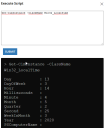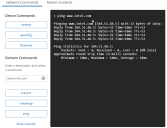Device actions
When you are viewing device details, the Actions panel allows you to perform actions on that device. The Actions panel automatically appears when you open the device details page, but if you don't see it, click the Actions button in the top right corner.
There are basic actions that are built-in, or you can execute custom actions that you configure yourself. This page describes the basic actions. To perform an action on multiple devices or to create a custom action, we recommend using Neurons. For more information, see Neurons Bots - Custom Action.
For information on other things you can do from the device details page, see Devices.
Prerequisites
-
This action requires the Global actions > Execute Script permission.
-
The device must have an Ivanti Neurons Agent installed.
Actions
Click the Execute Script action to open a panel where you select the environment for running the script, depending on the device type.
-
PowerShell: Choose this option for scripts written in Windows PowerShell syntax. Use it for advanced administrative tasks, system automation, and configuration management on modern Windows operating systems.
-
Command Prompt: Choose this option for traditional Windows Command Prompt (CMD) commands. Use it for simple file operations, batch files, and basic commands. Specify the user context for script execution on the remote device—critical for security and permissions:
-
System (Recommended for OS-level tasks): Execute the script with the highest privileges, typically as the LocalSystem account. Use this for operations that modify system files, services, or registry keys affecting all users.
-
Logged-on User: Execute the script with the permissions of the user currently logged into the device. Use this for tasks that modify user-specific settings or require access to the user’s profile.
-
Clicking Submit sends the script to the Ivanti Neurons Agent on the device, which then runs it. The script output is captured and displays in the command window. It may take a minute or two for the command results to display.
These actions require service management software such as Service Manager or ServiceNow. They also require a connector configured with action credentials.
When you create or update an incident, the information is sent to the service management software.
This action requires the Global actions > Detect Outages permission.
The device must have an Ivanti Neurons Agent installed.
Click the Detect Outages action to open a command window that shows the output of standard network troubleshooting commands you can run on the device, such as tracert, netstat, ping, ipconfig, and so on. For Domain Commands that require an IP address or domain name (such as tracert), type the address in the text box in order to run the command.
Increase your browser width if the output window is truncating results. To clear the output window, click Clear console below the network commands.
The Recent Incidents tab shows incidents imported from connected service management software, such as Ivanti Service Manager. The incidents are what have been created in service management software recently and are not necessarily related to the currently selected device. This allows you to see if other devices on the network have reported problems similar to what you may be seeing for the current device.
This action requires the Global actions > Remote Control permission.
The device must have an Ivanti Neurons Agent installed.
Click the Remote Control action to open a remote control session with the device in a new browser tab. For more information, see Ivanti Neurons Platform remote control.
Click the Remove device action to delete the device record from the Neurons Platform. If the device record was imported using a connector, the record may be imported again the next time the connector runs.
If you remove a device that was imported using a connector, it is usually imported again within 7 days. To restore the device sooner, you need to run the connector manually. For more information, see To run a connector on demand.
If you remove a device that has the Neurons Inventory engine installed, it is usually imported again within 10 days. To restore the device sooner, you need to run the Neurons Inventory engine on the device manually. To do this, in a command prompt on the device, run: C:\Program Files\Ivanti\Ivanti Cloud Agent\UNO.INVENTORY.ENGINE64\Inventory.Engine.exe" \runNow
This action requires the Global actions > Reboot Device permission.
The device must have an Ivanti Neurons Agent installed.
Click the Reboot action to send a reboot command to the agent on the device.
This action requires the Global actions > Install SWD Package permission.
To use this feature, the Connector Agent must be installed directly on the EPM Core Server"
Click the Install Ivanti Endpoint Manager package action to install an Endpoint Manager package on the device you're viewing. The target device must have an Endpoint Manager agent. The Ivanti Neurons Agent isn't required.
Before using the Install Endpoint Manager package action, you need to make sure your Neurons Platform Endpoint Manager connector configuration includes action credentials, which allows the Neurons Platform to perform actions on devices managed by Endpoint Manager. These credentials are configured separately from the credentials that let the Neurons Platform import Endpoint Manager data.
In the Endpoint Manager connector, enable Action Details and provide the following:
- Core Server: The core server's resolvable domain name or IP address, along with a username and password that can log on to the core server.
- Endpoint Manager: The username and password for an Endpoint Manager user.
For simplicity, users that are members of the LANDESK Administrators user group on the core server satisfy both credentials requirements.
There are two package installation methods you can choose from:
- Push a package: Installs the package on the targeted device. Will fail if the device is offline.
- Policy-supported push: Installs the package on the targeted device. Will retry automatically if installation fails or the device is offline.
To install an Ivanti Endpoint Manager package
- In the Neurons Platform, view the Device Details for the device you want.
- In the Actions list, click Install Ivanti Endpoint Manager package.
- Wait for the Neurons Platform to get the list of available packages from the connected core server.
- Select a package Install method.
- Select the package you want, and click Install. A notification tells you that the package install is scheduled.
- After the task is done, another notification tells you that the package install was complete, or if it failed it will tell you that. Use the Neurons Platform notification history if you think you might have missed the notification.
If you have an EPM connector configured with action credentials, and an EPM agent installed on the device you can perform the actions such as asking the device to check in or wiping the device. The actions available depend on the device operating system. For information about the actions, see Device actions in the Endpoint Manager help.
If you have a MobileIron connector configured with action credentials, you can perform MobileIron actions from the device details page. The actions available depend on the device operating system. The device must have a MobileIron client installed.
- Force check-in: Send a request for the device to check in immediately so that you can see if it is responding and so that it gets the latest policies. Supported for Android, iOS, and macOS.
- Send message: Sends a message to the device user. Supported for Android, iOS, and macOS.
- Unlock: Unlocks the device. Supported for Android, iOS, and macOS.
- Lock: Locks the device. Supported for Android, iOS, and macOS.
- Reboot: Reboots the device. Supported for iOS.
- Shutdown: Powers off the device. Supported for iOS.
- Reset PIN: Sets the PIN on the device to 0000.
- Wipe: Performs a factory reset on the device, erasing personal and company information. Supported for Android, iOS, and macOS.
To perform Avalanche actions from the device details page, you must have an Avalanche connector configured with action credentials, and the connector server must have an agent policy applied that includes the Avalanche engine. The device must have an Avalanche Enabler installed. The actions are only supported on Android.
- Force check-in: Send a request for the device to check in to Avalanche immediately so that you can see if it is responding and so that it gets the latest settings.
- Reboot: Reboots the device.
- Send message: Sends a message to the device user in the Enabler. If the Enabler is not in the foreground on the device, the Enabler shows a notification.
This action requires:
-
The Global actions > BitLocker> View BitLocker Key permission.
-
The BitLocker setting must be enabled in the Inventory Scanner.
-
This is applicable only for the Windows devices.
To view and retrieve BitLocker Recovery Keys:
-
Click Encryption Key in the Actions menu.
The Encryption Key dialog will display the Recovery Key IDs, which are unique identifiers for each BitLocker recovery key associated with the device. A device may have multiple Recovery Key IDs.
-
Select a Recovery Key ID to view its corresponding Recovery Key.
When the standard authentication fails, you can copy the recovery key and provide it to the user to unlock the BitLocker-encrypted device.

